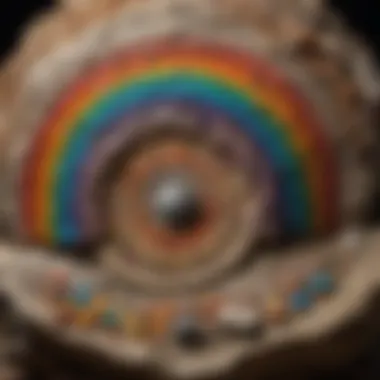Unveiling the Enchanting Spectrum of Colors in Rocks and Fossils


Rock and Fossil Identification
Rocks and fossils present a breathtaking spectacle of colors, each hue telling a story millions of years in the making. To identify these natural marvels, one must acquaint themselves with the diverse types of rocks and fossils available, ranging from sedimentary to metamorphic to igneous varieties. The key to accurate identification lies in discerning specific characteristics unique to each type, such as texture, mineral composition, and fossil imprints. Utilizing specialized tools like geologist hammers, magnifying lenses, and UV lights can aid enthusiasts in examining and distinguishing between different specimens.
Geological Insights
Delving deeper into the vibrant hues found in rocks and fossils unveils a fascinating tapestry of geological formations and processes. These structures offer valuable insights into Earth's history, illustrating the intricate metamorphic changes and sedimentary accumulations that have occurred over aeons. Exploring the historical significance of rocks and fossils provides a glimpse into ancient environments and life forms, allowing researchers to unravel the mysteries of past civilizations. Noteworthy discoveries in the field continue to expand our understanding of geological evolution and deepen our appreciation for the kaleidoscopic beauty preserved in these timeless relics.
Introduction
The realm of colors in rocks and fossils beckons us to a journey filled with wonder and intrigue. These natural formations, adorned in vibrant hues, offer a window into the geological processes that have shaped our planet over millennia. From the crystalline structures of minerals to the organic imprints in fossils, the colors embedded in these earthly treasures narrate a tale of ancient landscapes and biological evolution.
Unveiling the Spectrum of Colors
Understanding the Role of Minerals
Embarking on a quest to comprehend the palette of rock and fossil colors unfurls the pivotal role played by minerals. These inorganic compounds, with their distinct crystal structures and chemical compositions, govern the pigmentation of geological specimens. Minerals like azurite and amethyst exhibit unique colorations due to their inherent properties, captivating collectors and geologists alike. Exploring the mineralogy behind these hues not only illuminates the aesthetic allure of rocks and fossils but also unveils the geological history etched in every shade.
The Influence of Environmental Factors
In the canvas of nature's artwork, environmental factors serve as the invisible brushstrokes that influence the colors we observe in rocks and fossils. From the temperature and pressure conditions during mineral formation to the presence of trace elements shaping fossil hues, the environment leaves its indelible mark on these geological marvels. Understanding how external forces interplay with the intrinsic characteristics of minerals and organic matter broadens our appreciation for the kaleidoscopic spectrum present in Earth's crust. While environmental influences imbue rocks and fossils with their signature colors, they also pose challenges in preserving these chromatic time capsules.
The Science Behind Coloration
Delving into the intricate world of colors present in rocks and fossils is incomplete without exploring the underlying science that governs their chromatic display. Understanding the mechanisms behind coloration in geological formations provides invaluable insights into the geological history encapsulated within these vivid hues. By unraveling the science behind coloration, we can decipher the various processes and factors that contribute to the stunning array of colors found in nature's rocky tapestry.
Mineral Pigments
In the realm of geology, mineral pigments play a pivotal role in determining the captivating colors exhibited by rocks and fossils. The impact of crystal structure on mineral pigments is particularly noteworthy, as it influences the absorption and reflection of light within these geological specimens, thus dictating their color palette. The arrangement of atoms in the crystal lattice not only imparts distinct hues to minerals but also offers clues about their formation and geological context.


Impact of Crystal Structure
The impact of crystal structure on mineral pigments is paramount in defining their optical properties. The arrangement of atoms within the crystal lattice governs how light interacts with the mineral, resulting in the manifestation of specific colors. For instance, the presence of impurities or vacancies in the crystal lattice can lead to color variations, illustrating the delicate interplay between structure and chromatic expression.
This unique characteristic of crystal structure serves as a foundation for understanding the diverse colors observed in rocks and fossils, shedding light on the geological processes that have shaped these mineral formations over millennia.
Chemical Composition Variations
Alongside crystal structure, variations in chemical composition significantly influence the coloration of minerals. The elemental constituents present in a mineral contribute to its color properties, with trace elements often imparting distinct hues to the crystalline structure. Understanding these chemical nuances is crucial for discerning the pigmentation seen in different rocks and fossils, offering clues about their origins and geological evolution.
Exploring the realm of chemical composition variations unveils the intricate tapestry of colors adorning geological specimens, showcasing the rich diversity of mineral pigments that embellish the Earth's crust. By delving into these chemical intricacies, we can unravel the vibrant histories encapsulated within each colorful mineral formation.
Organic Matter Contributions
In addition to mineral pigments, organic matter plays a significant role in dictating the coloration of rocks and fossils. Biological pigments derived from living organisms, as well as the effects of decomposition on organic material, contribute to the chromatic palette seen in geological specimens. Understanding these organic influences adds another layer of complexity to the intricate world of colors in rocks and fossils.
Biological Pigments
The presence of biological pigments in rocks and fossils underscores the interplay between organic life forms and geological processes. These pigments, derived from ancient organisms, offer a glimpse into the ecosystems that once thrived on Earth, leaving their colorful imprints on the geological record. Examining the role of biological pigments enriches our understanding of the symbiotic relationship between life and geology, painting a vivid picture of the dynamic forces that have shaped our planet.
Decomposition Effects
Conversely, decomposition effects contribute to the color variations observed in rocks and fossils, representing the transformative power of organic breakdown on geological materials. The decay of organic matter within rocks not only alters their color profile but also provides insights into the environmental conditions that prevailed during their formation. Exploring decomposition effects in geological specimens unveils a chapter of Earth's history marked by biological interactions and natural decay processes, adding depth to the colorful anecdotes preserved in rocks and fossils.
This intricate interplay between biological pigments and decomposition effects underscores the multifaceted nature of coloration in rocks and fossils, weaving together organic and inorganic narratives to create a vivid tapestry of Earth's geological legacy.
Notable Colorful Minerals
Notable Colorful Minerals play a crucial role in the realm of rocks and fossils, showcasing a diverse array of hues that mesmerize enthusiasts and collectors alike. These minerals are not only visually stunning but also provide valuable insight into the geological processes that have shaped them over millennia. In this article, we will delve into the significance of Notable Colorful Minerals, discussing their unique properties, historical significance, and their relevance in both scientific study and aesthetic appreciation.


Vivid Examples in Nature
Azurite and Malachite
Azurite and Malachite are renowned for their striking shades of blue and green, respectively. These minerals often occur together, forming beautiful patterns and intricate designs in rocks and fossils. Their vibrant colors are a result of copper compounds present in their chemical makeup, creating a captivating visual display for collectors and researchers. Azurite's deep blue hue symbolizes wisdom and intuition, while Malachite's rich green tones represent growth and transformation. Both minerals offer insight into ancient geological processes and are highly sought after for their beauty and metaphysical properties.
Amethyst and Citrine
Amethyst, known for its stunning purple coloration, and Citrine, prized for its warm yellow tones, are popular choices for collections due to their radiant hues. Amethyst's royal purple hue signifies spirituality and enlightenment, making it a favorite among those seeking inner peace and clarity. Citrine, with its sunny yellow glow, is believed to carry the power of the sun, bringing warmth and positivity to its wearer. These colorful minerals not only enhance the aesthetic appeal of rocks and fossils but also hold symbolic meanings that resonate with enthusiasts and collectors worldwide.
Opal and Fire Agate
Opal and Fire Agate are captivating examples of the play of colors in nature, showcasing iridescence and fiery hues that captivate the imagination. Opal's kaleidoscopic display of colors represents hope and creativity, with each gemstone possessing a unique pattern that tells a tale of Earth's geological history. Fire Agate, with its fiery reddish-brown hues, embodies passion and vitality, often used as a protective stone to ward off negativity. These colorful minerals are prized not only for their beauty but also for their metaphysical properties, making them cherished additions to any rock and fossil collection.
Color Patterns in Fossils
Color patterns in fossils play a pivotal role in understanding the prehistoric world and its inhabitants. These patterns provide valuable insights into the original appearance of ancient organisms, offering clues about their environment, behavior, and evolutionary adaptations. By studying the colors preserved in fossils, researchers can reconstruct the visual aspect of long-extinct species, unlocking a treasure trove of information about past ecosystems. The intricate details of color patterns in fossils help scientists paint a more comprehensive picture of the Earth's history and evolution, enhancing our understanding of biological diversity over millions of years.
Preservation Techniques
Mineral Replacement Processes
Mineral replacement processes are essential mechanisms in fossilization, where minerals gradually replace organic materials in the remains of prehistoric organisms. This process occurs over geologic timescales, resulting in the formation of mineral replicas of the original organism's structure. The key characteristic of mineral replacement processes lies in their ability to create accurate and durable fossil specimens that retain intricate details of the organism's anatomy. These replacements serve as invaluable records of ancient life forms, preserving them for scientific study and educational purposes. Despite being a time-consuming process, mineral replacement ensures the long-term protection and conservation of fossils, safeguarding them for future generations to explore.
Trace Element Influences
Trace element influences refer to the presence of mineral traces within fossils that impart distinct colors and features to the preserved remains. These trace elements can alter the pigmentation of fossils, creating vibrant hues that offer visual clues about the ancient environment and depositional conditions. By analyzing the trace element compositions of fossils, researchers can unravel information about the geological processes that occurred during fossilization. The unique feature of trace element influences lies in their ability to enhance the aesthetic appeal of fossils, making them visually striking and scientifically significant. While trace elements contribute to the beauty of fossil specimens, they also pose challenges in terms of preservation, as certain elements may cause discoloration or deterioration over time. Understanding and managing trace element influences are crucial aspects of fossil conservation and research, ensuring that the colorful legacy of ancient life endures for generations to come.
Role of Colors in Geology


In the captivating landscape of geology, the role of colors plays a pivotal position, offering insights into the intricate processes and historical traces encapsulated within rocks and fossils. Colors in geology serve as visual representations of geological time, indicating the diverse mineral compositions and environmental conditions that influenced their formation. By studying the hues present in these natural specimens, geologists can unravel the hidden stories of Earth's ancient past and interpret the underlying mechanisms that shaped these remarkable formations. The significance of colors in geology extends beyond mere aesthetics, acting as valuable markers for dating, identification, and educational purposes.
Dating and Identification
Color Indicators of Geological Time
Color indicators of geological time hold a key role in deciphering the chronological sequence of Earth's history embedded within rocks and fossils. These indicators manifest through distinct color variations resulting from the specific minerals, organic compounds, and environmental factors present during their formation. By analyzing the color patterns, geologists can correlate them with established geological timelines, aiding in the precise dating of geological events. The unique color signatures such as variegated bands, iridescent hues, and pigment concentrations serve as reliable markers for stratigraphic correlation and temporal frameworks, guiding scientists in understanding the temporal evolution of Earth's geological formations.
Diagnostic Coloration Signs
Diagnostic coloration signs act as diagnostic tools for geologists, offering valuable insights into the mineralogical composition, depositional environments, and alteration processes affecting rocks and fossils. These distinctive color patterns serve as indicators of specific geological conditions, such as hydrothermal alterations, diagenetic changes, and metamorphic influences. By interpreting the diagnostic coloration signs, geologists can make informed interpretations regarding the thermal history, tectonic events, and diagenetic processes that transpired over geological time. The diagnostic color signatures, ranging from vibrant hues to subtle tints, provide crucial clues for reconstructing the geological history and environmental transformations that shaped the Earth's lithosphere.
Aesthetic and Educational Value
Visual Appeal for Collectors
The visual appeal of colorful rocks and fossils captivates collectors and enthusiasts, drawing them into the mesmerizing world of geological wonders. The vibrant hues, intricate patterns, and luminous displays exhibited by these specimens evoke a sense of awe and admiration, making them prized possessions in geological collections. The aesthetic allure of colorful minerals transcends mere visual appeal, resonating with collectors on a sensory and emotional level, fostering a deep appreciation for the Earth's natural beauty and diversity. By showcasing the exquisite colors and patterns found in rocks and fossils, collectors partake in a visual feast that celebrates the harmonious fusion of artistry and nature.
Teaching Tool for Earth Sciences
Colorful rocks and fossils serve as invaluable teaching tools for earth sciences, offering a tangible and vibrant way to engage students and enthusiasts in the realms of geology, paleontology, and mineralogy. The diverse colorations present in these geological specimens provide a hands-on experience for learners to explore the principles of mineral identification, rock formation processes, and geological interpretation. By incorporating colorful rocks and fossils into educational curricula, instructors can enhance the learning experience, stimulate curiosity, and foster a deeper understanding of Earth's geological history. These vivid natural artifacts not only educate students on the geological significance of color but also inspire a sense of wonder and curiosity towards the Earth's geological heritage.
Color Preservation and Maintenance
In the realm of rocks and fossils, the topic of color preservation and maintenance stands as a crucial element that warrants meticulous attention and care. Understandably, the vibrant hues found in these geological specimens are not merely decorative but serve as vital indicators of geological processes and historical significance. Maintaining the integrity of these colors is paramount in safeguarding the authenticity and value of these natural wonders.
Preventative Measures
Storage Considerations
Delving into the realm of storage considerations sheds light on the intricate balance between preservation and accessibility of colorful rocks and fossils. Proper storage conditions play a pivotal role in preventing color fading, mineral degradation, and overall deterioration of these geological treasures. The choice of storage methods, whether it be controlled environments, specialized containers, or archival materials, significantly impacts the longevity and vibrancy of the specimens.
Cleaning Techniques
When discussing cleaning techniques in the context of color preservation and maintenance, meticulous care and precision are of utmost importance. Different rocks and fossils require specific cleaning approaches to ensure that the colors remain intact and unaffected by aggressive cleaning agents. Gentle methods such as soft brushes, mild detergents, and controlled moisture levels are preferred to safeguard the delicate hues present in these geological marvels. It is essential to strike a balance between cleanliness and caution to avoid unintended damage or alteration to the colors of the rocks and fossils.







